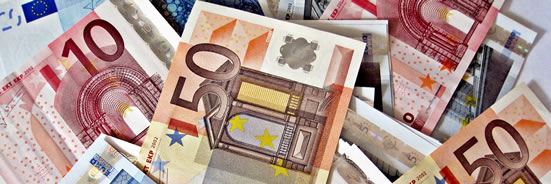- By Peter Lavelle
- Filed in: Day to Day
A contribution from Peter Lavelle, an economist at foreign exchange broker Pure FX, on the currency situation for an independent Catalonia.

What currency would an independent Catalonia use?
Catalonia continues to press for its independence. This past September 11th (the 299th anniversary of the fall of Barcelona, which led to Catalonia’s accession as part of Spain), 1.6 million Catalans linked hands around the region, to draw attention to their cause. Moreover, next year, Catalan president Artur Mas plans a referendum, to see just how much of the Catalan populous favours ceding from Spain.
However, aside from Catalonia’s ongoing struggle, the possibility of its independence raises certain questions. Like, for example, what currency would an independent Catalonia use? Well, that’s what I want to look at here. Read the rest of this article…
- By Sally Gurteen
- Filed in: Day to Day
One of my favourite writers, Sally, champions the district of El Raval in Barcelona.

Sally at the Barcelo 360 Bar
‘…the district of sinners, crooks and toughs, a maggot hill, a cesspit and cavern, a den of criminals. It is fetishized, endowed with causal powers, apparently destroying all moral and physical life within it… a terrible centre for infection, the pestulant bottom of a sewer, with its smell of sin and affliction. Many of the area’s inhabitants mutated into a subhuman race. Everyone has funereal features, the look of having recently been in hospital, the appearance of death. They don’t eat. They nourish themselves with alcohol, morphine, ether, ‘coke’ and wine’
An Imagined Geography: Ideology, Urban Space, and Protest in the Creation of Barcelona’s ‘Chinatown’ by Chris Ealham, c.1835–1936 Read the rest of this article…
- By Anthony
- Filed in: Day to Day
An article from Anthony Turner about his time in Barcelona in the 60’s.
As a young man back in the 60’s, I was inspired to visit Barcelona by Hemingway on reading two of his books; “Death in the Afternoon” and “For Whom the Bell Tolls”. I drove with my then fiancée (now my wife) down thro’ France, over the Pyrenees and on to Barcelona.
The city had pretty much embraced the “Swinging Sixties” and was then full of young people from the North…. Sweden, Norway, Denmark,Germany… all intent on enjoying the sun and having a good time. The austerity endured in the 50’s was over… young people were flocking in droves to Milan, St Tropez and Barcelona.
We spent much of our time in the Old Town Quarter getting to know the best and cheapest bars, although with an exchange rate of 169 pesetas to the £ we were not doing too badly! We drank local wines and I tried absinthe in an attempt to acquire inspiration of some sort! I understand that Hemingway drank a glass or ten in his favourite bar so the stories go! I believe that although absinthe was never banned in Spain, the Spanish were never much inspired by this drink as were the French for instance. Read the rest of this article…
- By Rob (H2BCN)
- Filed in: Day to Day
I found this infographic through Facebook. The Delegation of the Government of Catalonia to the United States of America Facebook page to be exact. It visualises the export statistics of Catalonia during 2012 in a way that’s easier to digest than reams of data.
What, how much and where do Catalan firms export?
Overview: Catalan exports reached a record level in 2012 with 58,289 million euros and a 5% growth. These figures are even better than pre-crisis figures. Read the rest of this article…
- By Rob (H2BCN)
- Filed in: Day to Day
This video was uploaded to YouTube in March of this year (2013), so is a very recent attempt at increasing awareness of the Catalan plight around the world. Even at half an hour it’s very fast-paced and I had no trouble sticking with it. And though the text is sometimes difficult to read it plays like a film trailer with evocative music that keeps you gripped. I thought it a great potted history of the Catalan state from the year 988 to the present day. If you’re outside of Catalonia and you don’t know what all the fuss is about I suggest you give it a watch.
As the quote from Carl Sagan at the start reads, “you have to know the past to understand the present”. Read the rest of this article…
- By Rob (H2BCN)
- Filed in: Day to Day

‘Saint George and the Dragon’ by Raphael (1505-1506)
I have written about La Diada de Sant Jordi before when I wrote about Valentine’s Day in Spain. But I thought I could expand on it a little this time around and mention a few other things that might interest you.
Many countries around the world have Saint George as their patron saint and most celebrate it on April 23rd (the accepted date of Saint George’s death in 303 AD).
Here in Catalonia (and a few other regions and cities in Spain) St. George is the patron saint too. And the Catalans certainly need little reason for a celebration. Read the rest of this article…
- By Richard
- Filed in: Day to Day
A friend was visiting Barcelona a while back. We met for breakfast and put the world to rights as we always do. He suggested he might like to write something for my blog. I had no idea what to expect. This is what he wrote.
Is the “English Gentleman” dead?

The English Gentleman: The Rise and Fall of an Ideal by Philip Mason
Ask a Barcelona barman or a Tottenham policeman and the answer is probably, “Yes.”
However it is interesting for me to notice that the concept is never translated. Whether in a Russian or Japanese conversation the words are always English. Was it a peculiar concept? Did people want to find it in Englishmen they met? In my travels, particularly to more isolated communities – like the peoples of Eastern Europe before the Wall came down – I think that they did.
Perhaps, with the advent of cheap travel, the hooligans now travel with the gentlemen or perhaps the gentlemen no longer exist!
In the 18th and early 19th century the English elite were fairly dissolute and were thought by many to be showing a bad example. Dr Thomas Arnold, the headmaster of Rugby school from 1828 to 1842, is credited with devising and encouraging the concept of the gentleman. It is a suit of many styles, fashioned to individual taste, but always of the same cloth. The gentleman was an enigma but you recognised him when you met him. Essentially he did things because he knew that they were right, not because they brought him personal advantage. Read the rest of this article…










